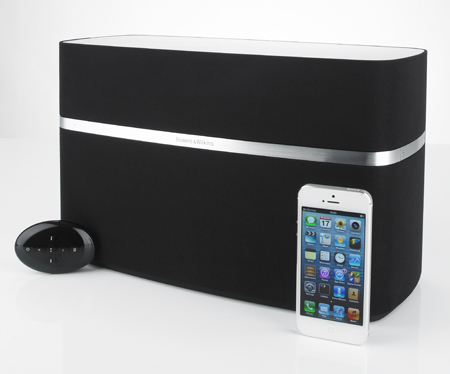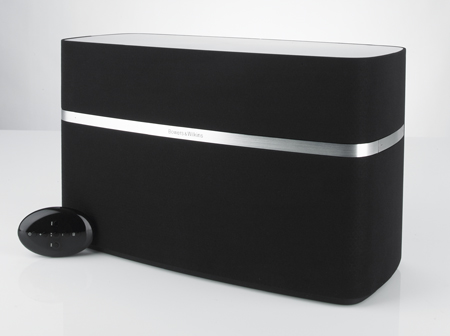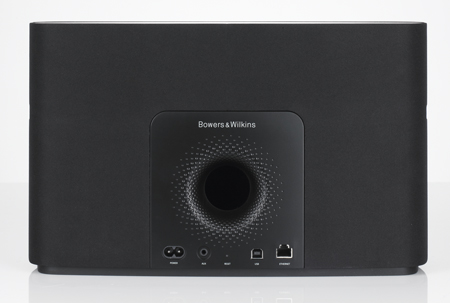What Hi-Fi? Verdict
If you want AirPlay and want awesome sound, the A7 demands your attention. But in a subtly styled way
Pros
- +
A fantastically deep, wide, well-organised musical presentation
- +
Bags of detail and clarity
- +
Awesome build quality
- +
Styled to fit in anywhere
Cons
- -
Some will find the styling unexciting
- -
Lacks the broad connection options of some alternatives
Why you can trust What Hi-Fi?
Compared with the name ‘Zeppelin’ (whether it’s followed by ‘Air’ or ‘Mini’ doesn’t matter at this stage), ‘A7’ is rather on the unadventurous side, isn’t it? But then, the styling of Bowers & Wilkins’ new A7 range-topping speaker unit is somewhat subdued, too.
As it happens, that’s the point: unlike the attention-seeking (and now iconic) B&W Zeppelin, the A7 is designed to blend into its surroundings. It doesn’t even have a dock. Instead, AirPlay is the primary connection, so you essentially place it out of the way, anywhere you like, safe in the knowledge that you can wirelessly transmit your tunes to it at the drop of an iDevice’s hat.
Of course, just because the A7 is designed to blend in doesn’t mean it’s dull or dreary – this is B&W after all. No, what you get for your £700 is a seriously solid block of classy audio design.
HANDS ON: B&W T7 review

B&W A7: Design and build
The black mesh that envelopes the casework is broken up by a brushed metal band, into which the Bowers & Wilkins logo is delicately etched. The only other detail on the typically unfussy face of the A7 is a single LED light that changes colour depending on which input is selected.
The sides are just as uncluttered. On the left, the metal band doubles as a power button, on the right it’s a volume control – while on the back there’s a neat row of inputs beneath the bass port.
That’s right, while the A7 is designed primarily as an AirPlay speaker, it still has a standard 3.5mm aux-in and a USB input for connecting a computer. There’s also an ethernet socket for those not yet ready to go entirely wireless.
Setup doesn't require a computer and is just about as simple as AirPlay gets, and once done your A7 appears whenever you press the newly orange-ified AirPlay icon on your Apple portable or iTunes computer.
B&W A7: AirPlay set-up
Setting up a Zeppelin Air when it first came out was a rather fiddly process that involved a computer, ethernet cable and network addresses. Now, thankfully, any Bowers & Wilkins AirPlay device you buy can be installed using the rather descriptively titled AirPlay Setup app.
Essentially the first time you turn on your A7 (or A5 or Zeppelin) it creates its own wireless network, which the app prompts you to connect to.
It’s true that doing so means having to leave the app and going into your phone’s wi-fi settings, but we suspect most iOS users will be perfectly comfortable with that – and B&W has included audio instructions for those who aren’t.
From there it’s back to the app, tap in your home network’s details and your A7 is connected and ready to go.

B&W A7: Multiroom system
And there’s nothing to stop you filling your house with multiple A7s, Zeppelin Airs or soon-to-be-released A5s to create a decidedly stylish and simple multiroom system.
True, you can send music from an iOS device to only one of these at a time, but a computer can stream to all of them simultaneously for when you want to entertain a party that’s spilled into every room of the house.
Sitting as it does at the top of the Bowers & Wilkins audio ‘dock’ range, the A7 comes with a great deal of sonic expectation. Can it really sound so much better than the excellent Zeppelin Air that it really justifies the extra £200 it commands?
Why yes. Yes it can.
B&W A7: Sound quality
It may share five drivers with the Zeppelin Air, but the bigger woofer and increased cabinet volume of the A7 results in significantly greater bass extension.
Play Poliça’s haunting I See My Mother and there’s a depth and gravity to the simple introductory bassline that the Zeppelin Air just can’t match, and that lends extra impact to the track, ensuring your engagement is immediate.
Although it rarely works this way, the Zeppelin Air’s broad wingspan can make you assume that it would be the better of the two at spreading sound to the left and right, but in practice it’s the A7 that provides the wider, more spacious soundstage.
In fact, the way it handles the strategically placed left and right effects of the track occasionally fools you into thinking you're listening to a pair of properly separated and toed-in speakers. Be in no doubt, this will fill all but the most humungous of rooms.

Despite looks, it’s no blunt instrument, either. The complicated, largely electronic strands of I See My Mother are disassembled and defined with truly impressive detail, while maintaining their cohesion to the presentation as a whole, and the vocals are projected with such clarity that it’s almost possible to make out singer Channy Leaneagh’s heavily vocoded and intentionally ambiguous lyrics.
Switching from that lossless Poliça track to play Bloc Party’s Real Talk via Spotify proves that the A7 can also work its magic on the more heavily compressed tracks it's likely to meet.
Here, the punch of the bass impresses as much as the depth and weight, and while the track is more narrowly mastered it still benefits from the A7’s exceptional ability to give each instrument its own space – it’s more like standing right in front of the band than a single box fed a compressed MP3 should ever really be.
Bowers and Wilkins has put a great deal of effort into making sure the A7 sounds good wherever it’s positioned, but we’d suggest that a few centimetres from a back wall is where it works best.

B&W A7: Bass performance
The bass remains admirably controlled even when there’s no gap behind the unit at all, but there is a bit more of it than is truly natural, while a spot far into the room will cost the unit some of the power with which we’ve become so keen.
If you want to hear the A7 at its very best you really need to consider plugging your computer into it. While The Mother from the soundtrack to The Road is detailed and subtly dynamic via AirPlay, playing it through the USB connection releases that extra degree of definition and nuance that makes it so achingly, beautifully melancholic.
Unsurprisingly, connecting a device using a standard 3.5mm analogue cable doesn’t result in quite the same level of audio quality, but it’s still a match for AirPlay, and those wanting to connect something with an optical output can use a mini-optical cable – that 3.5mm aux-in doubles-up as a digital connection.
B&W A7: Verdict
For some it will be a shame that B&W hasn’t sought to include DLNA or Bluetooth support, but the A7 is all about simplicity. It’s about having a sudden impulse to throw a tune from your phone and out into your room without fuss but with genuine hi-fi sound quality.
We’d say that’s a job well done.
MORE: Best AirPlay speakers
What Hi-Fi?, founded in 1976, is the world's leading independent guide to buying and owning hi-fi and home entertainment products. Our comprehensive tests help you buy the very best for your money, with our advice sections giving you step-by-step information on how to get even more from your music and movies. Everything is tested by our dedicated team of in-house reviewers in our custom-built test rooms in London, Reading and Bath. Our coveted five-star rating and Awards are recognised all over the world as the ultimate seal of approval, so you can buy with absolute confidence.


